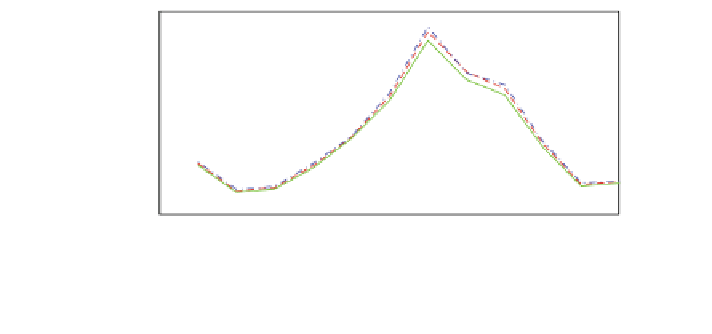Geography Reference
In-Depth Information
2000
1800
1600
1400
1200
1000
800
600
400
200
0
2
4
6
8
10
12
Month
Baseline
Centralized
Distributed
Fig. 6.21
Precipitation under different scenarios
temperature difference is also smaller. Temporally, colder month (in January as an
example) warming differences are small, but the hotter months (in July for
example) warming differences are much significant. From the perspective of
annual average level, the biggest warming difference still lies between centralized
urban land expansion scenario and decentralized urban land expansion scenario,
the minimum warming difference lies between centralized urban land expansion
scenario and baseline scenario. Among three scenarios, the warming effect caused
by underlying surface changes is widest and strongest under centralized urban land
expansion scenario. Under decentralized urban land expansion scenario, the
warming scope and magnitude caused by the underlying surface changes is the
smallest.
Under different scenarios of urban land expansion, the difference of impact of
underlying surface changes on precipitation is not particularly significant
(Fig.
6.21
). Overall, the precipitation of decentralized urban land expansion sce-
narios is maximum, slightly higher than the other two scenarios. The precipitation
of centralized urbanization scenarios is minimal, slightly lower than the other two
scenarios. From the aspects of time series, precipitation under different scenarios
presents an appearance of consistent monthly, the peak of precipitation appeared in
July. Precipitation differences among three scenarios are largest near precipitation
peak.
As the spatial distribution is concerned, precipitation under centralized urban
land expansion scenario and baseline scenario is relatively concentrated, while
spatial precipitation under decentralized urban land expansion scenario is rela-
tively dispersed (Fig.
6.22
). There is a wider scope, greater intensity of rainfall
centers under centralized urban land expansion scenario and baseline scenario.
Under decentralized urban land expansion scenario, precipitation center presented
decentralized characteristic, namely, there were two smaller and weaker precipi-
tation centers which are more evenly distributed in space.






































